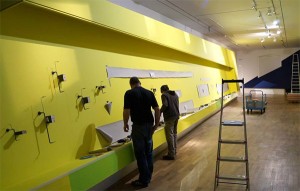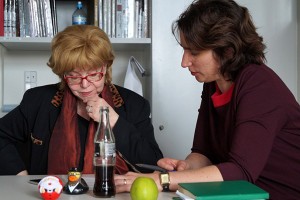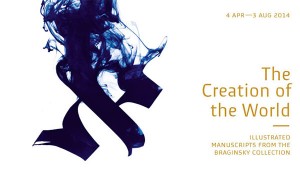An Interview with Cilly Kugelmann about the Exhibition “The Creation of the World: Illustrated Manuscripts from the Braginsky Collection”
Mirjam Wenzel: At the forthcoming exhibition, the Jewish Museum Berlin will present its first ever show of outstanding examples of the centuries-old Jewish scriptural tradition. What significance does scripture—the written word—have in the Jewish tradition?
Cilly Kugelmann: In early collections of rabbinic interpretations of biblical texts—the so-called midrashim—it is written that the Torah existed before the world was created. Some rabbis see the Torah quasi as a manual of creation that God drew on during his seven-day feat. Such interpretations demonstrate the extraordinary significance attributed to scripture in Judaism.
Following the loss of the geographic homeland Israel, sacrifices and pilgrimages to specific temples were abandoned in favor of prayer services that could take place anywhere—and the traditional texts themselves consequently became the most important, pivotal moment of the rite. To this day, the study and interpretation of biblical writings is the primary focus of Jewish intellectual life.
Why is René Braginsky’s Collection of illuminated manuscripts being presented under the title “The Creation of the World?”
Writing or, more specifically, copying passages from a Torah is a sacred act carried out by scribes especially schooled in the task. Judaism maintains that the Torah text was dictated by God and written down by Moses. The aim when copying is to make an exact reproduction and thereby always to bear in mind the pattern of the original text.
The Talmud tells of a meeting of Rabbi Meir and Rabbi Ishmael in the first century C.E., at which Rabbi Meir is asked what his profession is. “A Torah scribe,” he answers. “Be careful,” replies Rabbi Ishmael. “If you ever leave out or add only a single letter, you could destroy the whole world.” This demonstrates that the task of copying a Torah is analogous to the creation of the world. Through his work, the Torah scribe recreates the world—and his work may on no account be less perfect than God’s creation itself. This view of the Torah can be applied to the whole literary canon.
Exhibition visitors will be able to follow the work of a scribe, five days a week. What will he write?
The Torah scribe—who throughout the exhibition will spend two hours writing each day except on the Shabbat (Friday and Saturday)—will copy the book of Bereshit, the first book of the Pentateuch, which begins with the sentence: “In the beginning, God created heaven and earth.” In addition, he will inscribe parchment scrolls such as are traditionally kept either in mezuzah, the small cases in which supplications beginning “Shema Yisrael,” (“Hear O Israel”) are inserted then mounted on door posts in Jewish households; or in tefillin, the two leather boxes on leather straps which are attached to a worshiper’s forehead and left arm at morning prayers. He’ll inscribe a ketubah (marriage contract) too, and possibly also a get (divorce contract).
The exhibition “The Creation of the World. Illustrated Manuscripts from the Braginsky Collection” is the second exhibition in a row to present objects that are of central importance to Jewish rites. How does it relate to the previous exhibition, “A Time for Everything. Rituals Against Forgetting?”

Setting up of the exhibition “The Creation of the World. Illustrated Manuscripts from the Braginsky Collection”
© Jewish Museum Berlin, photo: Katrin Möller
“The Creation of the World,” our presentation of very beautiful, very precious, and partly illuminated manuscripts from the Braginsky Collection, is the next step in a small exhibition series through which we’re addressing Jewish thought, basic Jewish rituals, the development of customs and the arts and crafts they entail, and other religious traditions in greater detail. For over a decade, the Jewish Museum Berlin has presented the public with highly diverse exhibitions. Now it is time to offer deeper insights into the core issues of religious Judaism. In “A Time for Everything” we explored the imperative of remembrance. With this presentation of manuscripts from the Braginsky Collection, we turn our attention to the scriptural tradition, one of the most outstanding artistic accomplishments of Jewish culture.

